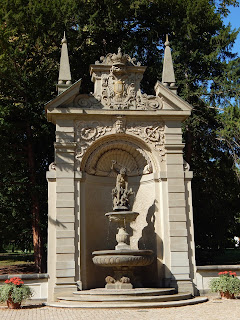If you take the 22 tram up towards Prague Castle from the centre of town (the most popular way to go) and disembark at the Pražský hrad stop, it is very easy to head straight through the security point and head directly towards the castle buildings via the Powder Bridge. But in doing so, you're likely to miss out on the Royal Gardens, described by some as the most historically valuable of the castle gardens.
Founded in 1534 by Ferdinand I, who acquired the land which was originally a mediaeval vineyard, the original gardens were inspired by Renaissance designs from Italy. From the very early days, the gardens were planted with exotic botanical specimens from all over the world. The current designs are based on ideas from 19th-century English parks.
 |
| The Hercules Fountain |
The buildings in the gardens were all built for the express purpose of the pursuit of leisure for the nobility rather than for any functional end. The most exquisite of these is the Ball Game Hall (Míčovna) which is covered in beautiful frescos. Built between 1567 and 1569 by the architects Bonifác Wohlmuth and Oldřich Aostalis, on the south side of the gardens, directly above the Stag Moat, the hall has also served as a riding school and stables and during the reign of Josef II, it was used as a military storage facility.
 |
| One of the archways on the Ball Game Hall originally open to the outside |
The frescos represent the personification of four elements (Earth, Air, Fire, Water), seven main virtues (Forethought, Restraint, Mercy, Hope, Justice, Bravery, Faithfulness), and eight free arts (Theology, Astronomy, Geometry, Music, Arithmetics, Rhetorics, Dialectics, Grammar). In the 1950s an emblem of a Five-Year Plan with a sickle and a hammer were added in the third arch on the left as an allegory of industry and agriculture. (This is the only preserved feature of social realism within the Prague Castle premises).
The hall was burnt down following fighting in May 1945 but the designs were painstakingly restored, first in 1952, and then further between 1971 and 1973.
 |
| The fresco representing faith |
 |
| and the art of Astronomy |
 |
| Looking back to the castle from the Royal Garden |
 |
| Looking down into the Stag Moat |
Unfortunately, the Royal Gardens are also only open during the extended summer season from April until October, but when they are open, entry is free. If you've enjoyed this, I've written about other gardens associated with the castle here.

